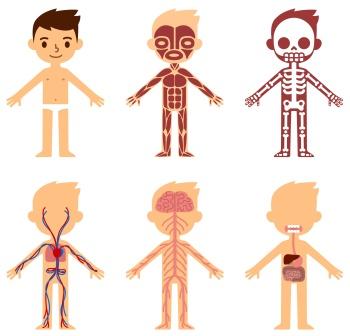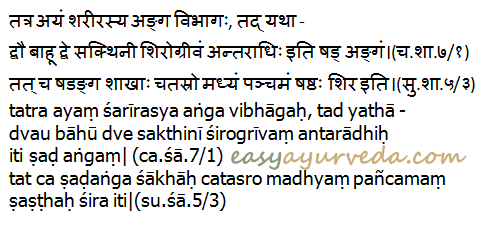Anga, Shadanga: 6 Divisions Of The Body As per Charaka, Sushruta

Article by Dr Raghuram Y.S. MD (Ay) and Dr Manasa, B.A.M.S
The human body is called by the name Shareera in Ayurveda. This Shareera is chiefly made up of 6 main organs or parts or segments. These 6 parts are called as Angas. Thus the shareera or human body is made up of Shadanga or 6 parts or segments (organs).
Table of Contents
Shadanga
Shadanga forms the major classification of body parts, in fact a gross demarcation or surface marking of the body into 6 large units. The Shareera (human body) is broadly made up of 6 large parts or units, i.e. Shadanga.
Shadang = Shad (6) + Anga (parts, segments)
The Shad Angas are
2 upper limbs,
2 lower limbs,
1 head and 1 trunk (central portion of the body)
Read related: Shareera: Formation Of Human Body, Ayurvedic Concept
Sanskrit verse

Shadangam as per Charaka
Charaka tells that the body is divided into 6 major parts (Shadanga) namely –
– Bahu – upper limbs, 2 in number
– Sakthi – lower limbs, 2 in number
– Shirogreeva – Head and Neck, 1 in number
– Antaradhi – Middle part of the body or trunk (comprising of thorax and abdomen), 1 in number
Shadangam as per Sushruta
Sushruta has given the same classification with change of names. According to him, the body is divided broadly into 6 parts (Shadanga), namely –
– Shakas – 4 in number (2 urdhwa shaka or upper limbs + 2 adho shaka or lower limbs)
– Madhyama Shareera – Middle portion of the body, 1 in number (trunk comprising of thorax and abdomen)
– Shira – Head, 1 in number
Shadangam as per Bhavamishra
Bhava Mishra further in his treatise Bhavaprakasha has further explained these 6 parts of the body (shadanga) on the basis of their importance and the structures which they are made up of. They are as follows –
– Shira (head) – Seat of Gnanendriyas (sense organs)
– Urdhwa Shaka (upper limbs) – seats of anguli (fingers)
– Adah Shaka (lower limbs) – seats of anguli (toes)
– Vaksha (chest) – seat of important organs like Hridaya (heart), Phuphusa (lungs), Stana (breasts) etc
– Udara (abdomen) – seat of vital visceral organs like Yakrut (liver), Pleeha (spleen), Kloma (Pancreas), Antra (intestines), Vasti (urinary bladder), Vrukka (kidneys), Guda (anus, rectum) etc
– Prushta (back) – seat of Prushta vamsha (spine, vertebral column) Kati (pelvis), Nitamba (hips, butt) etc
The explanation given by Bhavamishra doesn’t contradict with that of Charaka’s or Sushruta’s opinion. The classification is almost the same. Bhavamishra has subdivided Antaradhi (Charaka) or Madhyma Shareera (Sushruta) into Vaksha and Udara and have explained them separately. Bhavamishra has explained Prushta which blends with Antaradhi (Madhya shareera) and Shiro Greeva mentioned by Charaka and Sushruta. Bhavamishra has given more details regarding the contents of these 6 angas to demonstrate their anatomical importance which Charaka and Sushruta have done it separately, elsewhere.

Importance of Shadanga, Structures
Makes study of human body easy –
It is easy to study anything when done in fragments; the complicated machinery of human body is no exception. The core concepts of Rachanaa Shaareera or Anatomy in Ayurveda are exemplary. Ayurvedic seers have made anatomy easy by firstly classifying the human body into 6 broad landmark parts as seen from outside. They named them Shad Angas. Later the smaller landmarks or associated angas were described and were called pratyangas. Then the core interior of the body was described and each and every anatomical aspects were explained in depth namely ashayas (visceras), koshta (large spaces), koshtangas (visceral organs), srotas (channels of circulation), siras and dhamanis (blood vessels and nerves, lymphatics) etc were dealt with precision. It is always easy to learn things in step-ladder pattern.
Shad Angas include all structures of the body –
All components, tissues, organs and organ systems of the body fall within this broad group of Shadangas. Muscles, bones and other soft tissues helping in locomotion are included in the shakas (limbs) and prishta (back). Brain and sense organs, important nerves are located in the head (shiras). Vital organs like heart and lungs are seen to be placed in chest (uras) and important organs like liver, spleen, intestines, pancreas, kidneys, urinary bladder, uterus etc are found in abdomen and pelvic cavities (udara-kati guha).
Organs and structures controlling main life-activities are located in the Shad-angas –
Shakas – Limbs help in all the activities of daily living and also in locomotion.
Shiras – The control centre of all the activities of the body (brain) including control stations for thoughts, memory, emotions, judgment, etc, is located in the shiras (head). Shiras is also a place where all our sensory and motor activities are blended into synchronized life activities, is also a site of manas (mind) and indriyas (sense organs).
Antaradhi – The antaradhi or shareera Madhya (middle portion of the body, trunk) comprises of many organs related to important life-processes and are found located in uras / vaksha (chest cavity) and udara (abdominal and pelvic cavity).
– Vaksha is comprised of vital organs of circulation and ventilation, namely heart and lungs and other organs like trachea, esophagus, pharynx, etc, gives origin to aorta (greatest artery) and receives deoxygenated blood from all parts of the body through great veins i.e. superior and inferior vena cava.
– The udara and kati (abdomen and pelvic cavity) has important organs of digestion, urinary and genital apparatus (reproduction), immunity etc.
Also important are the below mentioned aspects of shadanga
– The endocrine system, the circulatory system, lymphatic systems are found scattered in all the shadangas
– 107 marmas or vital areas of the body which on getting injured or damaged either take away the life or cause temporary or permanent damage of the organs and tissues are scattered all through the shadangas
– The Doshas, dhatus and malas belong to the shadangas
– Hridaya (heart, brain) being a site of manas (mind) is located in the uras / shiras which are parts of Shadanga shaareera
Just Before Finishing –
Shadangas and Pratyangas are the first ever anatomical landmarks explained in medical science. The knowledge of these aspects has made ‘understanding anatomy’ an easy process. This article is an attempt to present the ‘importance of the study of Shadangas for better understanding of body and the arrangement of various structures within it’ to our voracious readers!!
Click to Consult Dr Raghuram Y.S. MD (Ayu)









